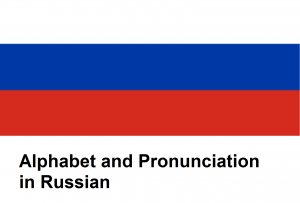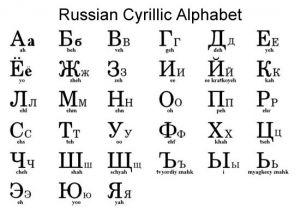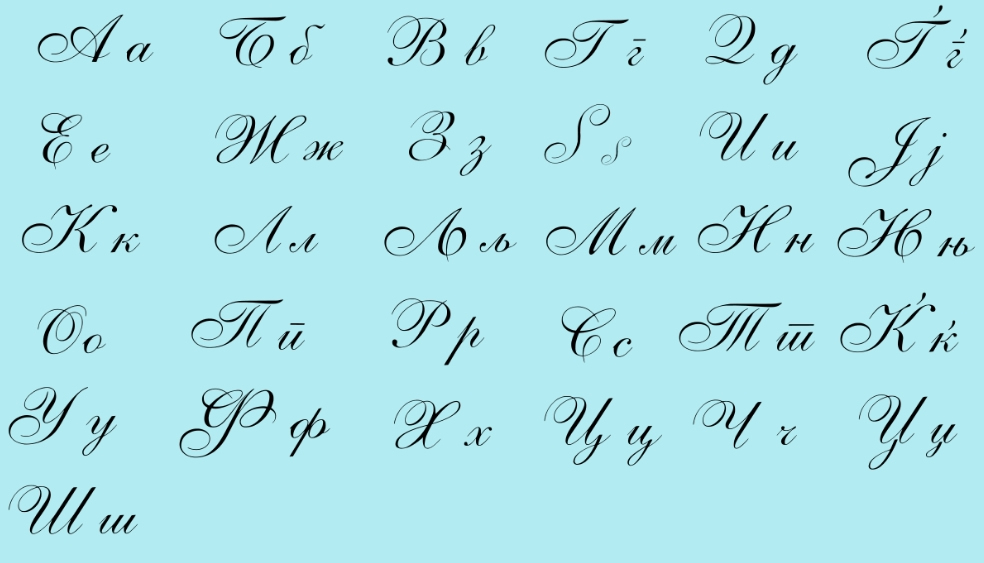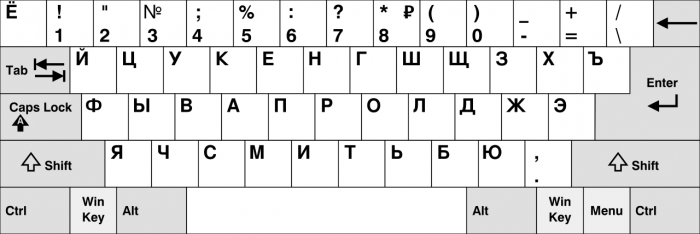Difference between revisions of "Language/Russian/Pronunciation/Alphabet-and-Pronunciation"
| Line 531: | Line 531: | ||
{| class="wikitable" | {| class="wikitable" | ||
|ад (ad) [at] | Hell | |ад (ad) [at] | Hell | ||
|- | |||
|яд (jad) [jat] | Poison | |яд (jad) [jat] | Poison | ||
|- | |- | ||
|мыло (mylo) [mɨlo] | Soap | |мыло (mylo) [mɨlo] | Soap | ||
|- | |||
|мило (milo) [mjilo] | Nice | |мило (milo) [mjilo] | Nice | ||
|- | |- | ||
|лук (luk) [luk] | Onion | |лук (luk) [luk] | Onion | ||
|- | |||
|люк (ljuk) [ljuk] | Hatch | |люк (ljuk) [ljuk] | Hatch | ||
|} | |} | ||
Revision as of 21:15, 24 March 2023
Привет! Russian lovers 😎! Welcome to today's lesson on the Cyrillic Russian Alphabet!
Russian is a Slavic language written with the Cyrillic alphabet. Russian has 33 letters in its alphabet with 10 vowels, 21 consonants, and 2 symbols (ь, ъ). It is similar to Ukrainian and Belorussian, and over 277 million people in Russia and 30 other countries speak the language.
In the table below, we'll explore the unique sounds of Cyrillic letters, and provide audio recordings to help improve your pronunciation. Listening carefully and practicing these sounds will help you master Cyrillic letter pronunciation. At the end of this lesson, you'll learn how to use a Cyrillic keyboard and have access to an online virtual keyboard as well.
Russian Alphabet and Pronunciation
| Caps | Minisculs | Name | Prononciation IPA | Transcription | English Equivalent | English Equivalent (sample word) | Letter Name in Russian | Sample Word | Sample Word (audio) | |
|---|---|---|---|---|---|---|---|---|---|---|
| А | а | а | /a/ | a | А а | Like "a" in car | "ah" |
|
||
| Б | б | бэ | /b/, /bʲ/ | b | B b | Like "b" in bat | "beh" |
|
||
| В | в | вэ | /v/, /vʲ/ | v | V v | Like "v" in van | "veh" |
|
||
| Г | г | гэ | /ɡ/, /gʲ/ | g | G g | Like "g" in go | "geh" |
|
||
| Д | д | дэ | /d/, /dʲ/ | d | D d | Like "d" in dog | "deh" |
|
||
| Е | е | е | /je/, / ʲe/, /e/ | e | YE ye | Like "ye" in yet | "yeh" |
|
||
| Ё | ё | ё | /jo/, / ʲɵ/ | ë | YO yo | Like "yo" in yonder | "yo" |
|
||
| Ж | ж | жэ | /ʐ/ | ž | Zh zh | Like "s" in measure or pleasure
or like "g" in beige (the colour) |
"zheh" |
|
||
| З | з | зэ | /z/, /zʲ/ | z | Z z | Like "z" in zoo | "zeh" |
|
||
| И | и | и | /i/, / ʲi/,, /ɨ/ | i | EE ee | Like "ee" in see | "ee" |
|
||
| Й | й | и краткое | /j/ | j | I i or Y y | like "y" in boy or toy | "ee kratkoyeh" |
|
||
| К | к | ка | /k/, /kʲ/ | k | K k | Like "k" in kitten, "c" in cat. | "kah" |
|
||
| Л | л | эл, эль | /l/, /lʲ/ | l | L l | Like "l" in light | "ehl" |
|
||
| М | м | эм | /m/, /mʲ/ | m | M m | Like "m" in mat | "ehm" |
|
||
| Н | н | эн | /n/, /ɲ/ | n | N n | Like "n" in no | "ehn" |
|
||
| О | о | о | /o/, /ɐ/ | o | Stressed: O o
Unstressed: A a |
Like "o" in bore
Like "a" in car |
"oh" |
|
||
| П | п | пэ | /p/, /pʲ/ | p | P p | Like "p" in pot | "peh" |
|
||
| Р | р | эр | /r/, /rʲ/ | r | R r | Like "r" in run (rolled) | "ehr" |
|
||
| С | с | эс | /s/, /sʲ/ | s | S s | Like "s" in sam | "ehs" |
|
||
| Т | т | тэ | /t/, /tʲ/ | t | T t | Like "t" in tap | "teh" |
|
||
| У | у | у | /u/ | u | U u | Like "oo" in boot | "oo" |
|
||
| Ф | ф | эф | /f/, /fʲ/ | f | F f | Like "f" in fat | "ehf" |
|
||
| Х | х | ха | /x/, /xʲ/ | x | H h, KH kh | Like "h" in hello or like the "ch" in Scottish 'loch'
or German 'Bach' |
"khah" |
|
||
| Ц | ц | цэ | /t͡s/ | c | TS ts | Like "ts" in bits | "tseh" |
|
||
| Ч | ч | че | /t͡ɕ/ | č | CH ch | Like "ch" in chip | "cheh" |
|
||
| Ш | ш | ша | /ʂ/ | š | SH sh (hard) | Like "sh" in shut | "shah" |
|
||
| Щ | щ | ща | /ɕɕ/ | šč | SH sh (soft) | Like "sh" in sheep | "schyah" |
|
||
| Ъ | ъ | твёрдый знак | '' | Hard Sign | Letter before is hard | "tvyordiy znahk" |
|
|||
| Ы | ы | ы | /ɨ/ | y | I i | Like "i" in ill | "i" |
|
||
| Ь | ь | мягкий знак | / ʲ/ | ' | Soft Sign | Letter before is soft | "myagkeey znahk" |
|
||
| Э | э | э | /e/ | è | E e | Like "e" in pet | "eh" |
|
||
| Ю | ю | ю | /ju/, / ʲu/ | ju | YU yu | Like "u" in use or university | "yoo" |
|
||
| Я | я | я | /ja/, / ʲa/ | ja | YA ya | Like "ya" in yard. | "yah" |
|
Notes
The Russian "l" is usually pronounced as a "dark L," which is produced with the back of the tongue raised toward the velum (soft palate). It is similar to the "L" sound in English words like "call" or "fall." This pronunciation can differ slightly depending on the specific dialect or accent of Russian being spoken.
At the end of the word, the sound consonants become deaf, as in German, they pronounce then:
- b > p
- v > f
- g > k
- d > t
- z > s
The Russian has 5 vocalic phonemes noted by 10 graphemes:
| a | e | i | o | u | |
| а | э | ы | о | у | After a hard consonant |
| я | е | и | ё | ю | After a soft consonant or yod |
NOTE: If Russian word contains 'ё', the accent is always on this vowel. Therefore, the accent mark is not placed above 'ё'.
The use of the letter 'ё' is mandatory in texts with consistently placed accent marks, in books for young children (including textbooks for elementary school students), in textbooks for foreigners. In ordinary printed texts, it`s written in cases where a misreading of the word is possible, when it`s necessary to indicate the correct pronunciation of a rare word or to prevent a speech error. The letter 'ё' should also be written in proper names. In other cases, the use of 'ё' is optional.
Minimal Pairs in Russian
| Hell |
| Poison |
| Soap |
| Nice |
| Onion |
| Hatch |
The table shows examples of minimal pairs in Russian, where the only difference between words is the presence or absence of the "soft sign" (ь) after the consonant. English speakers may find these sounds challenging to differentiate, as they do not exist in English. However, it is important to learn to distinguish them in order to accurately understand and pronounce Russian words.
For instance, the name of the first president of Russia was Борис Ельцин in Russian, which is transliterated as "Boris Yeltsin" in English. The letter "e" in Yeltsin is pronounced like "ye" in "yes" and the "ь" in Ельцин is pronounced as a soft "y" sound.
Italic characters
It's worth noting that some cursive Cyrillic letters differ significantly from their printed counterparts, and we've highlighted these distinct forms in bold for your convenience.
These cursive letters are essential to learn because they are frequently used in everyday Russian handwriting and closely resemble the handwritten form of the language.
By mastering these distinct forms of Cyrillic script, you'll be better equipped to read and write in a variety of settings and contexts.
| А а | Б б | В в | Г г | Д д | Е е | Ё ё | Ж ж | З з | И и | Й й | К к | Л л | М м | Н н | О о | П п | Р р | С с | Т т | У у | Ф ф | Х х | Ц ц | Ч ч | Ш ш | Щ щ | Ъ ъ | Ы ы | Ь ь | Э э | Ю ю | Я я |
| А а | Б б | В в | Г г | Д д | Е е | Ё ё | Ж ж | З з | И и | Й й | К к | Л л | М м | Н н | О о | П п | Р р | С с | Т т | У у | Ф ф | Х х | Ц ц | Ч ч | Ш ш | Щ щ | Ъ ъ | Ы ы | Ь ь | Э э | Ю ю | Я я |
|---|
Cursive Letters (hand writing
Watch the video below to learn how to write the cursive language letters of the Russian alphabet:
Russian Keyboard
Typing on a Cyrillic keyboard can be an effective way to improve your Russian writing skills in several ways:
- Familiarity with the keyboard: Regular practice on a Cyrillic keyboard can help you become more familiar with the layout and location of Cyrillic letters, allowing you to type faster and more accurately.
- Developing muscle memory: Consistent use of a Cyrillic keyboard can help you develop muscle memory, which means you can type without looking at the keyboard, allowing you to focus more on the content you are writing.
- Spelling accuracy: Typing on a Cyrillic keyboard can help you improve your spelling accuracy by providing visual feedback on the correct spelling of words in Russian.
- Writing speed: As you become more proficient at typing in Russian, your writing speed is likely to increase, allowing you to express your thoughts and ideas more quickly and efficiently.
- Consistency in writing style: Regular use of a Cyrillic keyboard can help you maintain consistency in your writing style by enabling you to use the correct letter forms and diacritical marks.
Real Russian Keyboard
A typical Russian keyboard has a similar layout to the standard QWERTY keyboard used in many countries, but with some additional keys specific to the Russian language. The letters of the Cyrillic alphabet, including both uppercase and lowercase characters, are printed on the keys.
Here is an example below:
Transform your keyboard to write Cyrillic
This video explains how you can write Russian/Cyrillic letter stickers on your native keyboard with the use of Russian letter sticker:
Russian Online Virtual Keyboard
Type directly without the need to change the settings of your device:
Videos
Russian Alphabet Made Easy
Learn the Russian alphabet with examples and pronunciation
Learn the Cyrillic alphabet in one video



